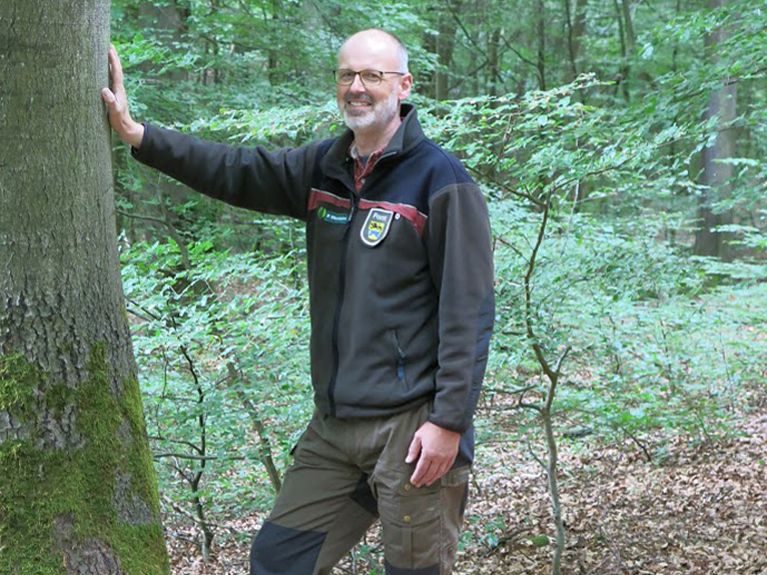The hidden life of the forest
The Germans have always had an intimate relationship with the forest. Now the forester and author Peter Wohlleben offers a new perspective on this unique environment.

Peter Wohlleben, 1.98 metres tall and bearded, leans against a beech tree, his right hand idly caressing the trunk. Despite an old superstition claiming the contrary, beech trees do not offer a safe haven in a storm, he explains. A film of water forms around the smooth bark of the tree, conducting the electricity straight to the ground. That’s why lightning does not create a furrow in the beech – as it does with the oak – when it strikes the tree. Wohlleben glances up; the wind is freshening and driving dark clouds over the forest, his forest. He smiles and says: “When people think of trees, they see them as sources of oxygen and shade, as water purifiers and providers of wood, but no one really considers how amazing these living beings are.” Peter Wohlleben is a forester in the small town of Hümmel in the Eifel region. At the same time, he is a bestselling author: his book “Das geheime Leben der Bäume” (The Hidden Life of Trees) is at the top of Germany’s bestseller lists, with his latest title “Das Seelenleben der Tiere” (The Spiritual Life of Animals) hot on its heels. Several foreign rights have already been sold. Wohlleben says: “I was just as surprised by the book’s success as anyone else.” When he and his wife looked for his tree book in a bookshop shortly after its publication, they found it in the esoteric section, which Wohlleben found amusing.
Peter Wohlleben bends down and picks up a leaf from the leaf-carpeted forest floor. “Essentially, what we are walking on is toilet paper,” he comments. “Before winter comes, trees free themselves of any surplus material by letting their leaves fall to the ground.” He even quotes Peter Maffay: “‘And when I go, only a part of me will go’ – this line from one of the German pop star’s songs could have been written by a tree.” He explains that dead trees are indispensable for the forest cycle. Over the course of the centuries, the forest draws nutrients from the ground, stored in wood and bark. “This constitutes a precious treasure for its children.”
It is now frequently claimed that Wohlleben has given the Germans back their forest. It’s the old business about the Germans and the forest again. There is no shortage of expressions of rapture – courtesy of writers such as Goethe, Tieck and Eichendorff. Tieck wrote about the forest as a place of retreat, claiming man only becomes human beneath the leafy canopy. Wohlleben has been taking people on guided walks through the forest for 20 years – showing, explaining and talking. People want stories. And emotions. Wohlleben’s rhetorical humanisation strategy is long tried and tested. In truth, Wohlleben is not giving the Germans back their forest. He explains trees to them so that they can better understand the forest. Unlike the Romantics, he does not ask what the forest can do for our salvation, but what we can do for the forest.
In a number of chat shows, Wohlleben has demonstrated how skilfully he is able to translate scientific findings into everyday language, how confidently and sympathetically he achieves this, and with such a wonderful sense of humour. He repeatedly talks about fungi, which he says act in much the same way as the Internet’s fibreglass cables. “They are to be found all over the forest floor, and in some cases also conduct electrical signals. At the same time, they also distribute sugar solutions. One teaspoon of forest earth contains several kilometres of these wafer-thin strands.” The scientific term for this network structure is the “Wood Wide Web”.
Trees, he says, can even count. In March there may well be a few warm days, but the trees wait before starting to bud. Why? Because of the possibility of a late frost. “Researchers at the Technical University of Munich have discovered that the trees count the number of days on which the temperature rises above 20 degrees Celsius. They only start to bud once a certain number has been exceeded.” Wohlleben is a scientist, not a New Ager.
While he was still working for the State Forestry Administration, he was a “plantation optimiser” – his job was to exploit the forest’s resources. In Wohlleben’s head, trees became processed timber. Every day he would assess the market value of beeches, firs, oaks and pines. Which were best suited to fine veneering, and which were only good for firewood? He saw trees not for what they were but for what they could become.
Economically speaking, the biggest disadvantage of the forest is its slow pace of growth. It takes ages for a tree to reach a decent height. Though this may be nature’s plan, it does not fit in with today’s world, which is why foresters intervene and ensure that the young trees – kept in check by the mighty trees around them – receive more light so that their trunks thicken more quickly and can be harvested sooner. Officially, this is known as forest rejuvenation, but Wohlleben describes it as “destruction”. Such an approach is unthinkable in his forest. Wohlleben used to hate the fact that words like efficiency, flexibility and profit maximisation would dictate his dealings with nature. Born in 1964 and with a wife and two children, Wohlleben handed in his resignation in 2006. His current employer, the municipality of Hümmel, is just as convinced as he is that careful use of the forest and profit are not mutually exclusive. Sitting at the kitchen table back at home a little later, Wohlleben explains that he could now travel all over Germany giving lectures every evening. But he has no time for that, as first and foremost Peter Wohlleben considers himself the guardian of his forest. ▪

